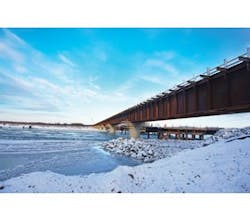Postal delivery workers aren’t the only ones who work year-round in all conditions.
The crews of Kiewit Infrastructure West working on the Northern Rail Extension Phase 1A to build a 3,300-ft-long bridge over the Tanana River in Salcha, Alaska, worked nonstop to complete the project by the October 2014 deadline. The span—which is now the longest bridge in Alaska—will provide the U.S. military with year-round road access to the Joint Pacific Area Range Complex (JPARC), its largest training ground, and the Alaska Railroad Corp. will have the first section of a four-part network that will connect Fairbanks with Delta Junction 80 miles to the south.
With so much riding on the project, Kiewit was required to finish construction in just two seasons, which spurred the year-round operation. This meant dealing with temperatures as high as 90°F in the summer and as low as -70°F in the dead of winter.
“Most construction shuts down during the winter months in Alaska, which means November to April,” said Justin O’Brien, project manager for Kiewit. But crews pushed on, working in tented heating stations and running equipment 24 hours a day for fear it wouldn’t turn back on. The Tanana River itself proved a formidable foe, building up ice sheets 5–6 ft thick in some areas.
Things did not get any easier once the ice melted, as the river’s channels often shifted from one season to the next. “One channel moved almost 2,000 ft between the first and second winters,” Gagnon told Roads & Bridges. These constantly changing conditions meant work areas shifted as well. Crews were forced to move their in-water access—a combination of rock causeways and temporary trestles—each season to accommodate the river shifts.
With such volatile conditions on the water, scour was a major concern. Predictions had scour levels reaching as high as 50 ft, so the columns had to be designed accordingly. Each column measures 29 ft with pilings up to 170 ft long. Weight restrictions on the local roadway, however, meant the piles could only be shipped in 43-ft-long sections. To work around this constraint, Kiewit set up a sub-arc welding bed on-site to create 86-ft-long pilings, which could then be stacked as needed.
To ensure that the bridge and local communities would be protected from the temperamental Tanana River, the project team built a levee from on-site sand and gravel, utilizing a riprap launching toe design. The final result was the state’s second-longest flood-control structure.
“This river isn’t one you’d find anywhere in the lower 48,” Gagnon proclaimed. R&B



